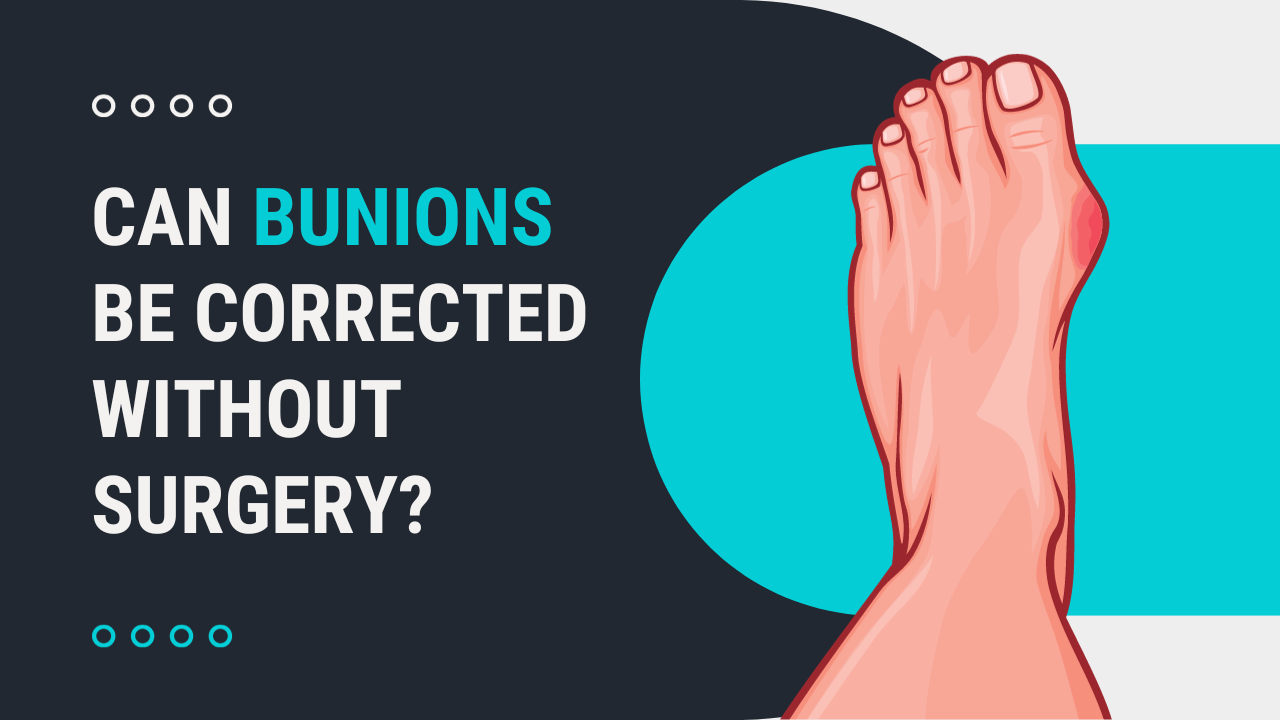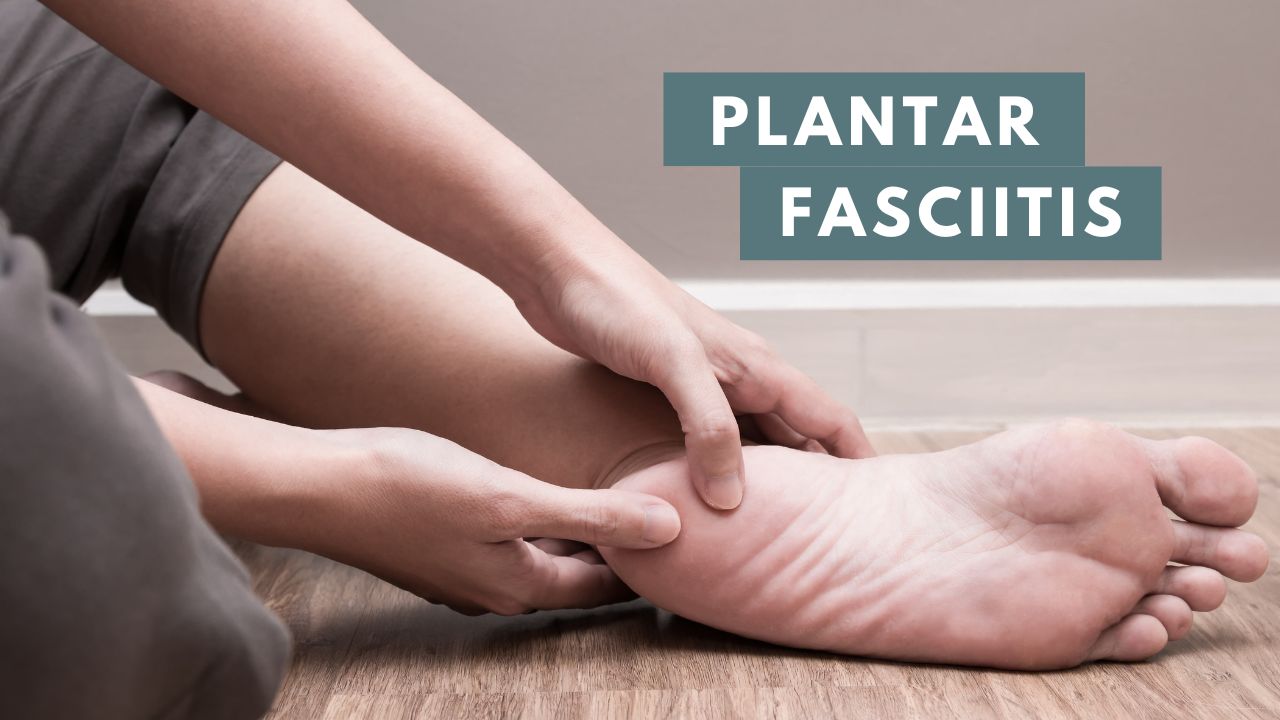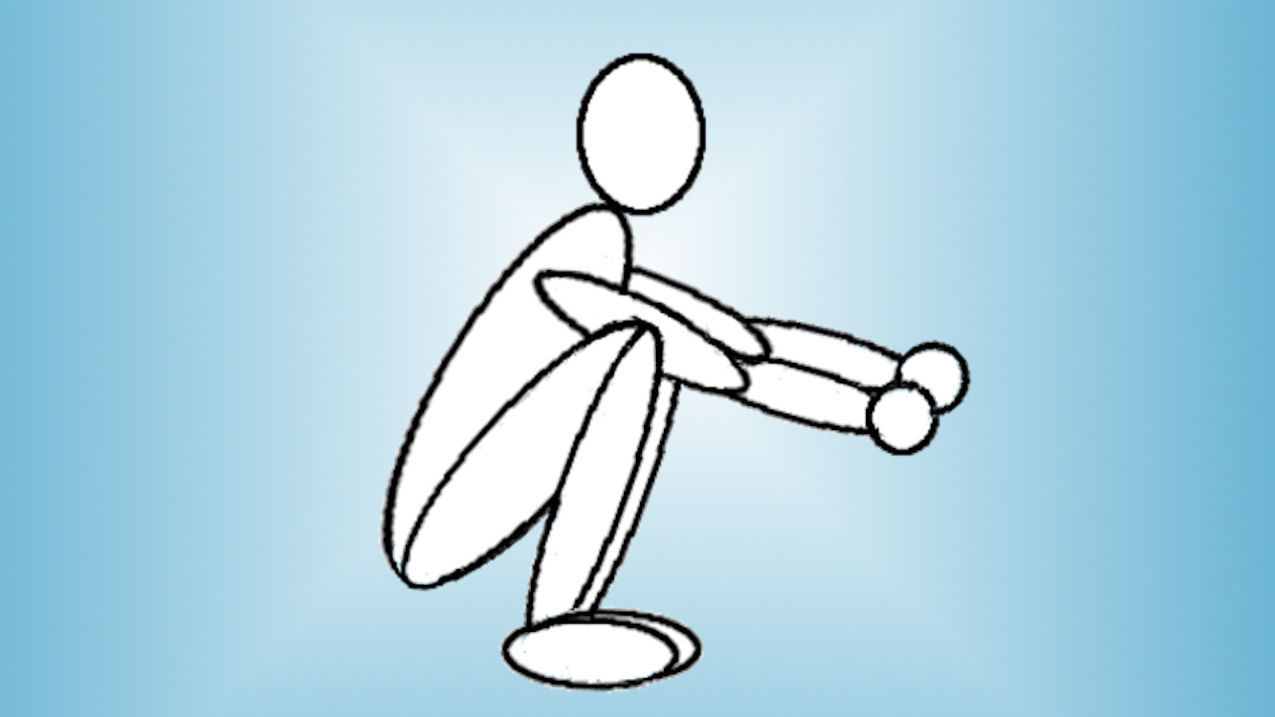If you look at most shoes from the side you’ll notice that the sole curves up near the toes. This design feature is called a toe spring.
What is Toe Spring?
Toe spring in shoes refers to the upward curvature of the front of the show. Its purpose is to allow for a rocking motion of the foot as weight is shifted from the heel to the toes.
To see the toe spring in action, place a shoe on a flat surface then press down on the front of the shoe directly over the toe box.
If the shoe you’re testing has a toe spring the heel should lift up into the air. How high depends on the height of the spring and the stiffness of the sole.
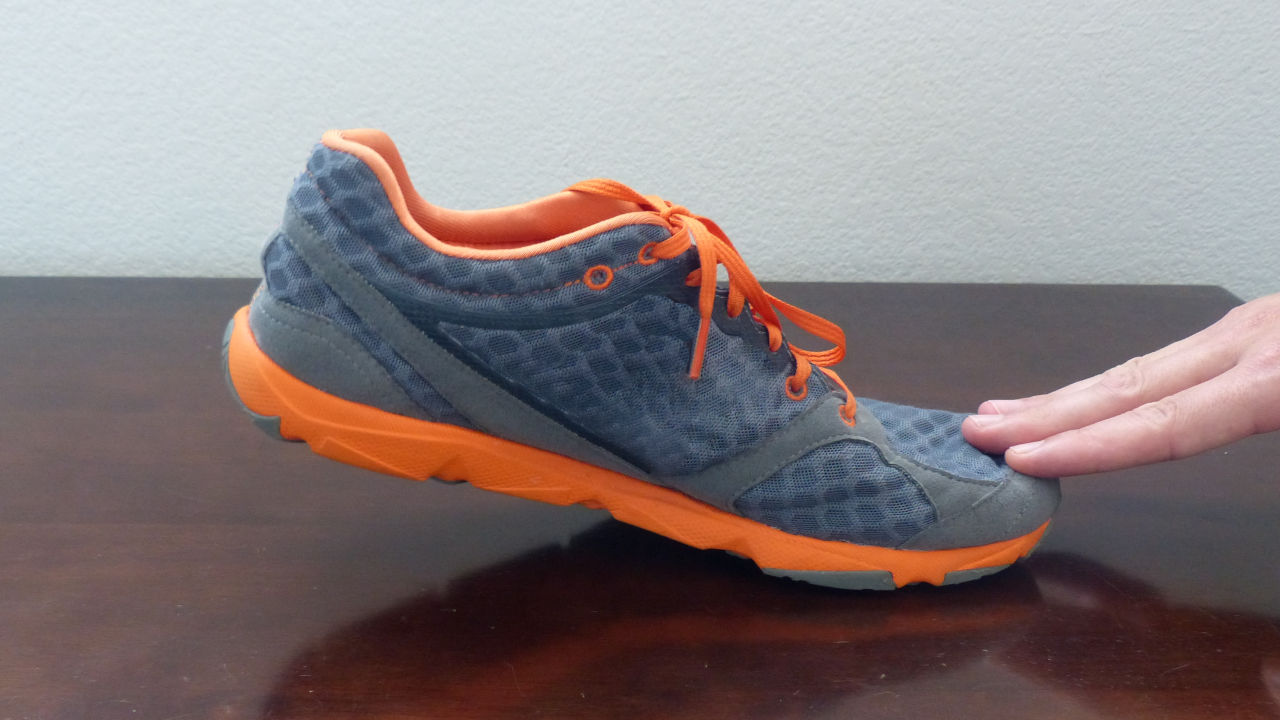
This effect doesn’t happen when you press down on your foot. So, obviously, the toe spring is going to have some effect on how you stand and walk.
Is Toe Spring Bad?
When you stand or walk barefoot your toes are flat against the ground, so why would shoes be designed to curl up in the front?
Each foot has 26 bones and over 30 joints, making it a highly flexible and highly complex structure. At the end of each step, the heel lifts off the ground and the toes flex to propel the body forward. The sole on most shoes is formed as one solid piece of material. Different shoes have different amounts of flexibility in the soles. Without separate articulations a shoe cannot match the true movements of the foot.
A toe spring is added to the design of the shoe to create a rocking motion as a substitute for the normal mechanics of the foot.
Toe Spring Alters Foot Stability
The first major issue I see with the toe spring design is that the toes are going to be held in an elevated position off the ground most of the time. This places the muscles on the underside of the foot into a stretched position and restricts their ability to generate force.
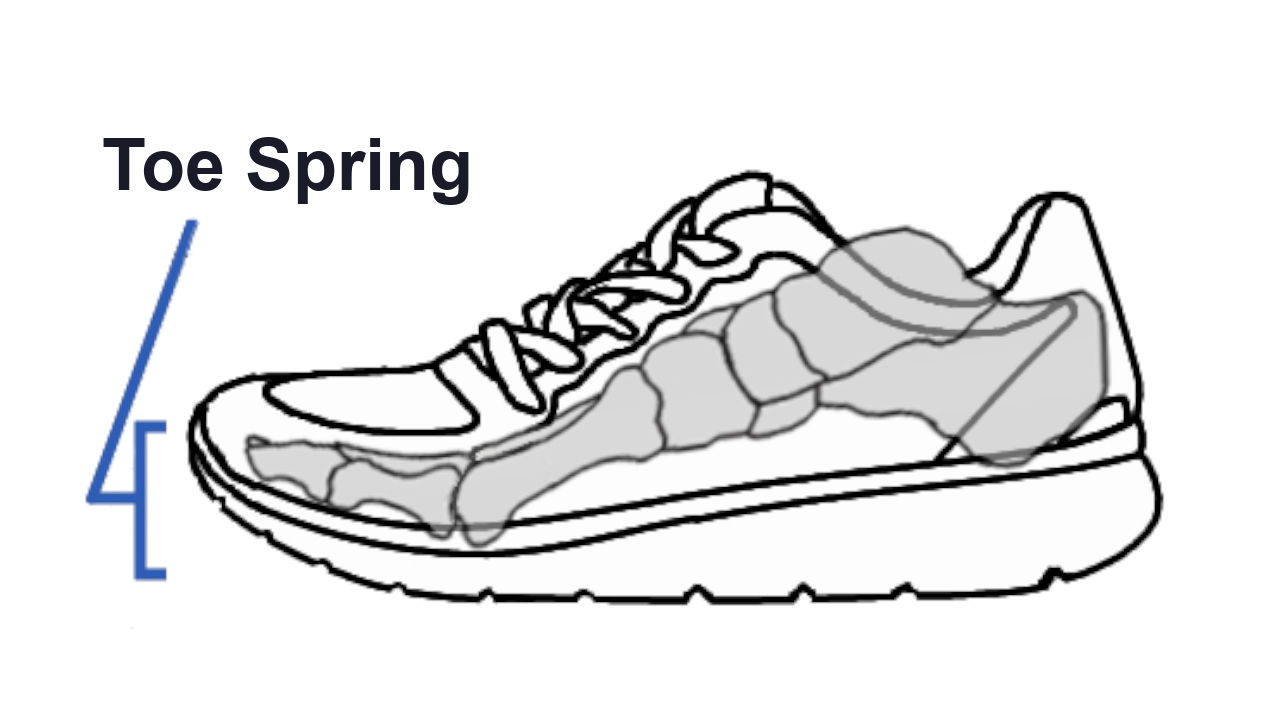
Normally the toes would be pressed firmly against the ground providing a stabilizing force to the arch during the majority of the stance phase of the gait cycle. Walking with a toe spring, the toes are not going to engage the ground until the heel begins to lift up, making it difficult for the foot intrinsic muscles to assist in controlling the rate and degree of pronation. The effect would be similar with running, except in cases where the runner is striking the ground with their forefoot.
Whether or not the muscles of the foot become weaker over time due to this is hard to say. Without these muscles stabilizing the foot, a likely result could be an excessive amount of pronation. Other structures that assist in supporting the arch will be under an increased load, but likely working from a mechanically disadvantaged position. Additional features engineered into the shoe may provide stability, but how well can this compare to the dynamic functioning of the foot’s own support mechanisms?
Change in Shock Absorption
The altered position of the muscles and ligaments caused by the toe spring will alter the shock absorption ability of the foot. Pronation is the part body’s natural system for absorbing ground forces. If the timing or magnitude of pronation is altered due to a restriction of the foot by the shape of the shoe then the way in which forces are transmitted through the leg are likely to be altered as well. Adding cushioning to a shoe may offset this effect, but again there is the question of how adequately can a shoe replicate the complex biomechanics of the foot.
Plantar Fascia
With diminished capacity of the muscles, more stress is going to be placed on the ligaments holding the bones of the foot together. The plantar fascia, located on the under side of the foot, is also going to be placed in a stretched position by the toe spring by way of the windlass effect. Normally the plantar fascia works like a spring itself.
During ground contact and loading the plantar fascia elongates and as the heel comes off the ground it shortens again to help reform the arch and make the foot a rigid lever to push off. With a toe spring, the plantar fascia will continuously be held in an elongated position. This could potentially. It will also influence joint movement and the impact forces sustained through the foot.
The ultimate cause of plantar fasciitis is still unclear. It’s understood though that in order to remain healthy, tissues require an appropriate amount of stress placed on them. Either too much or too little activity or force can lead to the tissue degrading.
Stress shielding is a term used to describe the weakening of bones, tendons, or ligaments when an inadequate amount of stress is applied to them, such as what might occur with disuse. The plantar fascia and the flexor digitorum brevis muscle both attach to the heel in the location where plantar fasciitis symptoms are usually present. Stress shielding is one of the theories about how plantar fasciitis develops. From what I described above, the case can be made that inactivity of the flexor muscle or inappropriate stress going through the plantar fascia could be a factor in the development of the condition.
Toe Spring Benefits
Enhanced Performance
During the 2012 summer Olympics, a sprinter generated some controversy by racing with an artificial leg, designed very much like a spring, that some argued gave him an unfair advantage despite his disability of having double below-knee amputations. Spring type prostheses are commonly used, not just for amputees, but for a number of other conditions of the foot and ankle. Typically they are designed to replace a function that for whatever reason the foot is unable to perform. This is frequently the case in individuals who have weakness or difficulty coordinating movements of the foot or ankle.
I’ve seen some advertisements for shoes with large toe springs imply the shoe will increase performance by returning energy to the athlete. It is possible that the toe spring helps conserve energy, which would benefit performance. But you have to wonder the implications in light of how the curved sole alters a runner’s mechanics. Basically, the shoe is substituting its own spring, for the natural spring activity that can no longer be generated by the foot because of the shoe. Replacing one spring with a different type of spring may not always produce a desirable result, particularly in regard to how the substitution changes the way impact forces pass through the leg.
Foot Irritation
Another potential drawback to eliminating the toe spring is that more material would be covering the forefoot. This extra material would fold on itself when the shoe flexed. If the material is displaced to the point it comes in contact with the toes it could potentially lead to skin irritation and blisters.
It should be noted that some shoes designed without a toe spring that also have a flexible sole end up developing a natural toe spring with use.
Possible Tripping Hazard
A toe spring creates clearance under the front of the foot. It’s possible the front of a shoe without a toe spring would be more likely to catch on objects on the ground.
Summary
- A toe spring is designed to allow shoes to compensate for their inherent lack of flexibility
- A toe spring holds the toes in an elevated position during standing and much of the gait cycle, contrary to the way the foot functions without a shoe
- This upward position of the toes may adversely affect the muscles on the underside of the foot and plantar fascia, can result in poor diminished pronation control, and can alter the shock absorption capacity of the foot
Should toe spring be something to consider when buying shoes? This is a tough question to answer because a lot comes down to personal preference. I look for shoes with little if any toe spring, among other factors like a wide toe box and flexible sole. But wearing a shoe with an inflexible sole without a toe spring could potentially carry its own set of problems.
